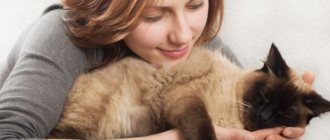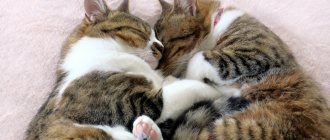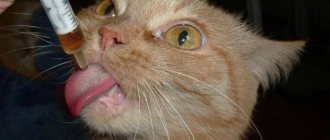Pregnancy of a pet is a joyful and important event. Cats become sexually mature by 6-8 months and, if the owner does not plan to sterilize her, you need to be prepared for childbirth. When a female gives birth for the first time, it is especially exciting.
Nature made sure that cats did everything on their own, but sometimes it needs to be stimulated. Street animals often find a secluded place and do not bother their owners. But helping a cat give birth in a city apartment is often necessary.
How to prepare? What to do when your cat doesn't push well? What drugs should I use? When to see a doctor? What to do if a cat gives birth for the first time? We will answer these and other questions further.
Stages of pregnancy
Short-haired and hairless breeds bear kittens for 55-65 days, long-haired breeds – up to 75 days. Pregnancy time also depends on the number of babies in the womb. The more kittens, the faster the birth will occur. However, if there are 1-2 cubs in the litter, then they can be expected with some delay.
ATTENTION! Sometimes one meeting with a male is not enough. Conception can occur a third or subsequent times, so it is difficult to determine the exact date of pregnancy at home.
Let's trace the stages of pregnancy for clarity:
- By the 20th day, the cat’s nipples become rounded, turn pink, and may peel. The female moves less and avoids high surfaces. He prefers sleep to active games and eats heavily several times a day. The belly increases slightly, but in long-haired breeds this is not noticeable. When palpating, you can feel the developing fetus, but this should be done carefully, because hasty actions will harm both the cat and the baby.
- From day 40, the fetus begins to actively develop. Gradually, limbs, head, and tail are formed. Internal organs are being formed and the nervous system is developing. Subsequently, the fetus acquires features inherent in cats, and also acquires sparse hair. The cat gradually loses its appetite.
- By week 6, the fruits descend into the abdominal cavity and stretch out. The belly is noticeably rounded, but if there are only one or two kittens, the changes are practically invisible. The abdominal cavity increases noticeably and takes the shape of a pear.
- After the 50th day, future kittens move actively. If there are many of them, then there is not enough space for everyone. The cat is experiencing discomfort. The expectant mother experiences vaginal discharge and colostrum appears from the nipples. The pelvis relaxes, and any day now the cat will give birth. She restlessly walks around the apartment or lies for a long time in a pre-prepared nest.
Maine Coon, British, Persian and Sphynx cats often require owner intervention and, in rare cases, veterinary intervention.
Duration of labor and alarming symptoms
- contractions are clearly continuing, but the kitten has not appeared for more than an hour;
- it is clear that the kitten is stuck (it is walking backwards or is too large, sometimes you can help yourself, as discussed below);
- the temperature in cats during birth rose above 39.5°C or fell below 37°C;
- discharge from the vulva is profuse, bloody, purulent, and smells disgusting;
- the cat is weakened, makes no attempts to expel the fetus, lies prone, breathes weakly;
- the heart rhythm is disturbed (the heart will beat very quickly, but it should “beat” smoothly, without jumps, fading, etc.).
Preparation
Preliminary measures will not be superfluous, although most breeds cope well with pregnancy on their own . So what should you do if your cat gives birth for the first time?
First , we set up a nest. A regular cardboard box is perfect for this. We put a diaper or any other fabric on the bottom for convenience. Experienced owners recommend using several layers of soft paper or baby diapers. Special houses for cats are suitable for nesting. The main thing is that the expectant mother has free access.
Secondly , the cat should build a nest in a warm, ventilated room. We exclude drafts and the presence of other animals. We exclude the toilet and bathroom. The ideal option would be a small room where the cat will not be disturbed. For example, a storage room.
Thirdly , in order for the pet to successfully give birth, it is provided with food and clean drinking water. All this is placed near the nest or place where the cat prefers to sleep. Presumably she will give birth there.
What items will be needed to help the cat, stimulate and speed up the process? The list may change, but if the owner has most of the above, then half the battle is already done:
- Disposable diapers and wet wipes.
- Scissors.
- Disposable syringes and a number of medications to eliminate complications.
- Vaseline oil to stimulate the vaginal muscles.
- Surgical (or silk) thread to tie the umbilical cord.
- Iodine, brilliant green, disinfectants.
Complications during childbirth
Of course, births in cats do not always go well. Sometimes unexpected complications happen.
If the kitten gets stuck during birth, do not allow the cat to bite through the bubble. In this position, the baby may suffocate. You can help the kitten: during the next contraction, gently pull him by the body. To improve patency, pre-lubricate the emerging part of the newborn’s body with Vaseline.
If a cat cannot give birth, she needs help
You may even have to urgently call a veterinarian for help. Such measures should be taken in the event of:
- long-lasting contractions, without the birth of babies;
- if the cat does not give birth for a long time, she experiences severe weakness, rapid heartbeat, body temperature above 39 degrees, loss of consciousness - urgently call a doctor at home;
- Bloody or purulent discharge with an unpleasant odor appears from the cat’s genitals.
The need to induce labor
Stimulation of labor is used in cases of late lambing or a prolonged interval between the birth of babies (more than an hour), when the pet cannot give birth on its own.
You need to wait some time. When 1-2 kittens are born, labor may subside and then reactivate (in some cases it can take up to a day). Labor can be stimulated by massaging the mammary glands and nipples. In extreme cases, it is possible to use oxytocin, a drug that promotes contractions of the uterine wall. It should be borne in mind that improper use of the product can cause the death of the mother and offspring.
What to do if the fruit is large?
How to help a cat give birth to a large kitten? Even if he moves head first, his shoulder area can prevent birth.
We fix the problem this way:
- After lubricating the vagina, insert your finger inside and try to feel the elbow bends of both paws of the kitten one by one.
- Grab each paw at the shoulder joint.
- Turn the baby from side to side, try to alternately stretch its paws forward.
- If the baby is in the lower part of the birth canal, force the pet to push. To do this, you need to stretch the vagina.
If the fruit is large, the cat needs help
What to do if a cat cannot give birth?
If the animal is unable to give birth on its own even under the influence of Oxytocin, it is necessary to immediately contact a veterinarian. The doctor may resort to a last resort option - a caesarean section. Many owners are afraid of surgery, but it is considered the safest method of treating fetuses without risking the life of the animal. The procedure is carried out in several stages:
- they use general anesthesia, during which the cat falls asleep and cannot move;
- the peritoneum and uterus are incised;
- the fruits are removed along with the amniotic sacs and placenta;
- suturing the uterus and abdominal wall;
- use an antiseptic to eliminate the risk of infection;
- waiting for the hypnotic effect to end.
Causes of problems
Taking a dip at home is quite easy. It doesn’t matter if it’s a village house or a city apartment. But in some cases, the pregnancy period has passed, and the cat still does not give birth, although all the signs are obvious. The kittens will continue to grow, taking away strength and energy. The larger the fetus, the more difficult the birth will be . They should not be tightened.
Let's list the main reasons why a cat is unable to go into labor on time:
- malposition;
- the kitten is too big;
- narrow pelvis;
- insufficient amount of lubricant;
- incomplete dilatation of the cervix;
- age of the cat;
- mechanical injury;
- inflammation of the genital organs;
- the cat is overweight;
- breed characteristics - dwarf, Himalayan;
- anatomical properties of the vaginal vault.
Weak labor activity stands out. There are two main types. The first is a slight tone of the uterus. It is caused by a lack of the hormone oxytocin. In rare cases, calcium. The second occurs when labor lasts more than a day, the cat has lost a lot of strength and can no longer push.
To avoid the problems described above, a pregnant cat is taken to a veterinarian before giving birth. He conducts examinations and makes recommendations if any of the listed anomalies are detected. In rare cases, hospital observation is required to prevent the death of a cat and its offspring. This could be a clinic in Moscow or a good provincial one.
Norms and deviations in labor
How to determine when labor activity does not meet the norms? There are no specific instructions, since each cat's body is individual. The only standard that the owner can rely on is experience and conditionally established time frames.
The birth of a cat is usually divided into three stages: contractions, pushing and expulsion. Contractions can begin 10–12 hours before birth. If your cat is not closely monitored, you may not notice the first contractions. The interval between the first, weak contractions can reach 30–40 minutes.
Already in contractions, the cat can behave quite actively, take food and water. The only way you can tell that your cat is going into labor is the lack of sleep. With the onset of contractions, stimulating hormones are released into the cat's blood, which prevent the cat from getting pregnant. We can say that the cat physically cannot sleep during contractions, and if she falls asleep, labor will stop (which also happens).
Note! A day, and sometimes several hours before giving birth, the cat refuses food, takes the nest and actively looks after itself. You may notice that your pet has begun to purr rhythmically. In this case, the purring sound will intensify during the contraction.
The strongest contractions occur at intervals of 30–40 seconds. Such frequent contractions indicate that the first kitten has already approached the birth canal and pushing will soon begin. Normally, a cat makes 2-3 attempts to expel the first kitten. After the first pregnancy, a fetal sac containing fluid appears from the birth canal, which bursts on its own or is opened by the cat. The next 1–2 attempts will push the kitten out, the cat will begin to lick it, gnaw the umbilical cord and eat the released placenta.
How to induce labor at home
It should be understood that there are a large number of drugs on the market. In any case, it is better to consult a veterinarian who will take into account the individual characteristics of the cat. A number of drugs are excellent at inducing and accelerating the birth of your pet. Let's look at the main medications that are used for stimulation:
- Oxytocin . Perhaps the main drug used in difficult childbirth. However, incorrect dosage can lead to bleeding and cervical rupture. Before use, consultation with a veterinarian is required!
- Travmatin . Used as an analgesic and prophylactic for difficult childbirth. Travmatin is effective in healing wounds with damage to the genital organs. Prevents infection of the uterine cavity by pathogenic microbes.
- Gamavit. Directly stimulates the muscles of the uterus. Often used in prolonged labor and difficult cases.
- Calcium gluconate . A lack of this element often leads to complications along with oxytocin. The drug increases labor activity as it acts. It also provokes the formation of milk. Used to relieve nervous tension after childbirth.
A lack of calcium leads to the development of eclampsia - acute postpartum depression, which negatively affects the nervous system. Causes severe cramps. In advanced cases it leads to the death of the animal.
Veterinary practice knows cases when labor can be induced without the use of medications. Let us note two main methods.
Option one
The owner puts on gloves. Puts the cat in a position where she goes to the toilet "in large quantities." Next, massage the abdomen in a circular motion. After a couple of minutes, dip your finger in Vaseline oil and insert it into the cat’s vagina about a centimeter. Circular movements are repeated again. Mechanical actions help stimulate and speed up labor.
Option two
When oxytocin is contraindicated for a cat for some reason or the owner does not risk using it, then the following method will come to the rescue. In a disposable syringe, mix 2 ml of ascorbic acid, 4 ml of glucose, 4 ml of calcium gluconate. We administer intramuscularly or intravenously, but only after the female has given birth to her first baby.
For every 5 kg of weight, 1 ml of the resulting solution is sufficient . It is also used after childbirth as a prophylaxis against eclampsia.
Help the kitten
- make sure the kitten is breathing. If your baby has swallowed mucus, use a syringe to remove the liquid from the nose and mouth. If this does not help, wrap the baby in a waffle towel and thoroughly, but carefully, rub the back from the butt to the neck;
- if the kitten is very weak and seems lifeless, after removing mucus from the respiratory tract, apply a cotton swab with ammonia to the nose. If it doesn’t help, put one drop of cognac on your tongue. If it doesn’t help, wrap the baby in a waffle towel and gently shake him several times (the head should be fixed). Artificial respiration is performed mouth to nose, dosing oxygen very carefully, since the baby’s lungs are very small.
- pinch the umbilical cord with your fingers at a distance of a couple of centimeters from the tummy;
- squeeze it for about fifteen seconds to compress the capillaries;
- cut the umbilical cord at the point of compression and make sure that there is no bleeding. If blood does appear, tie the umbilical cord with alcohol-soaked thread at a distance of 1.5 cm from the tummy, and burn the tip with potassium permanganate or treat it with brilliant green.
SIMILAR ARTICLESMORE FROM THE AUTHOR
Stages of the procedure
Specialists note several stages that precede the birth of kittens. The cat walks restlessly, the babies are actively moving in the stomach.
The first stage of labor begins . It lasts up to 24 hours. The cat's body temperature drops by 2-3 degrees. This is a natural process. The cat actively licks the nipples or genitals. In some cases, vomiting is observed. It is better to transfer the expectant mother to a previously prepared nest. There she will feel safe and prepared for childbirth.
The cat's water breaks and her pulse quickens . Breathing is occasionally interrupted. The contractions began. The pet meows loudly, sometimes turning into a scream. The owner calms the cat down by talking and lightly stroking the belly.
The second stage begins . The abdominal and diaphragm muscles are activated. The cat is pushing hard and the baby is gradually moving forward. The amniotic sac partially ruptures and fluid flows from the vagina.
Many owners are interested: is a kitten born feet first or head first? In this, cats copy humans. Like a human baby, a kitten is born head first. But it is worth noting that birth with the pelvis or paws forward should not cause concern to the owner. This is natural for cats.
The mother licks the baby, freeing it from the amniotic sac. Cats often eat this afterbirth. It is rich in vitamins and minerals. But a large amount of afterbirth eaten causes indigestion. The optimal quantity for a female is 2 pieces. In most cases, the cat chews the umbilical cord on its own.
ATTENTION! The number of afterbirths exactly corresponds to the number of kittens. Sometimes their number does not match. This means that one of the placentas remained inside the uterus. It must be removed to prevent inflammation of the genital organs in the future.
The final, third stage comes into force. The animal's uterus comes to rest until the next kitten appears. The break between births lasts from 10 to 60 minutes. The cat can drink and rest a bit.
The time of birth is an individual value. But if they continue for more than 24 hours, you should contact your veterinarian.
What not to do during childbirth
Sometimes the owner of a mustachioed friend can harm the animal due to inexperience.
To prevent this from happening, take a close look at the list of things that are strictly forbidden to do when giving birth to a cat:
- Do not pull a newborn cat by the head or neck.
- It is also forbidden to pull too hard on just one paw.
- It is prohibited to use antiseptics that are intended for treating human wounds.
- Do not allow a giving birth cat to eat more than two placentas.
- It is prohibited to turn on bright lights in the maternity ward. Moreover, it should not be included in the first 2-3 weeks of a kitten’s life, as this can cause cataracts.
- In the first 2-3 hours, try not to pick up newborns. Leave them in the care of the mother: she will lick and warm the babies on her own.
What kind of help will you need?
So, we figured out how to induce and stimulate labor. But in some cases complications may occur. You will need the owner's help. Let's look at the most common cases and specific actions. It is especially useful for people to know when a cat gives birth for the first time:
The fetus is large and does not pass through the uterus
We have found that it is preferable for a kitten to be born head first. There is nothing wrong with walking feet first, but it often causes complications for the cat. What to do if the fruit is large?
We put on gloves, having previously lubricated our fingers with Vaseline oil. We insert a finger into the vagina and feel the folds of the kitten’s paws. We move the baby from side to side, trying to stretch the limbs forward. We grab the paws in the area of the shoulder joint.
Sometimes the baby is far from the exit of the uterus. We provoke contractions in the cat by stretching the vagina.
The cat did not chew the umbilical cord
It is worth waiting 10-15 minutes; if the woman in labor does not take any action, then you need to help her. We squeeze the umbilical cord with two or three fingers at a distance of 3-4 centimeters from the kitten’s belly. We tie it with silk or surgical thread. We take sterile scissors in our hands. Surgical ones are better. We cut the umbilical cord. We treat the cut site with an antiseptic.
The kitten is not released from the amniotic sac
We wait one or two minutes and cut it ourselves. We take out the kitten and wrap it in cloth. We hold our head and bend our body so that our knees reach our chests. We perform the manipulations several times. Breathing should resume . If it does not appear, then perform artificial respiration. If necessary, remove amniotic fluid from the nose and ears with a pipette.
Kittens are still born
It’s a scary situation, but we don’t lose our composure. Sometimes severe contractions, low temperature or an abundance of mucus in the nasal cavity lead to the fact that the kitten only looks dead . We dry the baby. We clear the airways, turn the head down and gently shake. Next we put it on the mother’s chest.
The cat definitely gives birth to dead pets one after another. We palpate the female's belly. If one or two fetuses are felt, then immediately contact the veterinarian. A caesarean section may be required.
Can't give birth
If the female pushes weakly, then we use oxytocin, calcium gluconate or a solution of ascorbic acid and glucose . If the drugs do not help, then immediately contact the veterinarian. Resuscitation may be required.
The cat may bleed. If it continues for a long time, you should contact your veterinarian. The same applies to unpleasant vaginal discharge. There should be no sudden drop or rise in temperature.
If contractions last more than two hours, but labor has not begun, contact the clinic . This could be Moscow or any other city. It happens that two fruits try to pass at once.
Especially during the first birth, it is better not to take risks and seek help from specialists. Any complication will negatively affect the pet’s health. To the point of being unable to give birth again .
We use medications only after consultation with a veterinarian. It is good if another family member or friend provides assistance during childbirth.
When a cat may need help
If events did not unfold according to the scenario described above, then your help is needed. How to help a cat give birth at home?
A) The cat is pushing, but the kittens are not coming out.
It is necessary to carefully insert a pipette lubricated with Levomekol into the vulva and make sure that the baby is not stuck in the birth canal. After this, we inject 1 ml of Gamavit into the withers and begin to stroke the cat’s belly in the direction of the fetal movement “towards the exit”.
The afterbirth should come out with the kitten
B) If you see that the kitten is stuck, then simply lubricate the paths with Vaseline.
C) The kitten was born, but the cat did not open its bladder - cut the bladder with sterile scissors, remove the kitten and clear its airways. After drying with a soft towel, apply it to the mother.
D) The cat has not chewed the umbilical cord - tie it with a 4 cm thread, cut it off and treat the break with an antiseptic.
E) The kitten came out unconscious - perform an impromptu heart massage: rub it with a towel, shake it lightly, clearing the respiratory system.
E) The cat is choking and convulsing - inject calcium gluconate (1 ml) intramuscularly.
It is not recommended to carry out the measures described above on your own; it is better if you know about them, but a veterinarian will carry them out.
If you see that the kitten is stuck, then lubricate the paths with Vaseline
Also, a cause for concern is the timing, which is very different from the standard - 2 months, or 60 days. If a cat gives birth prematurely, there is a high risk of stillbirth or death of the offspring after birth. The absence of births for more than 70 days may indicate a frozen pregnancy, when the kittens died inside the mother. In this case, you need to urgently take measures to save the cat.











